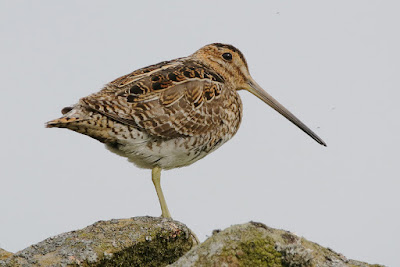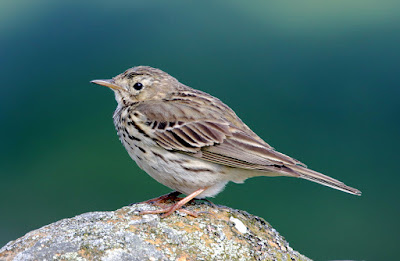With a forecast of a good sunny morning I decided to have a drive up to the hills to see how things were going in this belated spring. With luck I’d have three hours of birding before the parades of wannabe Bradley Wiggins’ showed up in their day-glow clothing and very loud voices that scare the birds away.
It’s a forty minute drive and a bridge over the northbound M6 before I hit the beginnings of the Trough of Bowland.
"Click the Pics" for a closer look.
"Click the Pics" for a closer look.
Bowland, Lancashire
Bowland
The quiet of early morning was broken mostly by the sounds of displaying Curlew and Lapwing. To lesser extent were the calls of Oystercatcher, Redshank and Snipe, all in the throes of establishing their breeding territories but the last three tend to be later breeders.
Redshank
Oystercatcher
Snipe
I lost count of the Mistle Thrush seen and/or heard. From every bit of suitable woodland or copse came their loud, fluty song.
Mistle Thrush
If Meadow Pipits have been rather thin on the coast they were around in large numbers this morning flitting around on every stretch of fence or dry stone wall for miles. Again, I lost count, or rather made no attempt at a total as they were just everywhere.
Pied Wagtails were numerous but not nearly so many as pipits. I found a couple of pairs of Grey Wagtail along Marshaw and Tower Lodge streams. It was at Tower Lodge that I both saw and heard Siskins, Lesser Redpolls and a single male Redstart.
Pied Wagtails were numerous but not nearly so many as pipits. I found a couple of pairs of Grey Wagtail along Marshaw and Tower Lodge streams. It was at Tower Lodge that I both saw and heard Siskins, Lesser Redpolls and a single male Redstart.
Meadow Pipit
Meadow Pipit
Pied Wagtail
I saw at least 4 Wheatears on the journey. They seemed very mobile and were probably migrants.
Wheatear
Not so the Red-legged Partridge, in loud song from a dry stone wall. Our Red-legged Partridge is not native to Britain but instead are feral or left overs from autumn shoots of released birds. Altogether it is an attractive bird that is able to hack it in the English countryside, unlike our native Grey Partridge which has become a rare sight in modern Lancashire.
Red-legged Partridge
Bowland, Lancashire
And while we are on the subject of Bowland, here’s an udate on the case against Bleasdale Estate gamekeeper James Hartley. Previous post here. Mr Hartley faced 9 charges as follows:
The only bird of prey I saw while driving through Bowland on Saturday was a single Kestrel. The killing goes on.
Log in soon to see more birds on Another Bird Blog.
Linking today to World Bird Wednesday with Stewart.
- Disturbing the nesting site of a Schedule 1 wild bird (13/04/2016)
- Killing a Schedule 1 wild bird (13/04/2016)
- Killing a Schedule 1 wild bird (14/04/2016)
- Setting trap / gin / snare etc. to cause injury to a wild bird (between 13-14/04/2016)
- Taking a Schedule 1 wild bird (14/04/2016)
- Possessing a live / dead Schedule 1 wild bird or its parts (14/04/2016)
- Possessing an article capable of being used to commit a summary offence under section 1 to 13 or 15 to 17 (13/04/2016)
- Possessing an article capable of being used to commit a summary offence under section 1 to 13 or 15 to 17 (between 12/04/2016 – 27/04/2016)
- Causing unnecessary suffering to a protected animal – Animal Welfare Act 2006 (between 14/04/2016 – 15/04/2016)
The only bird of prey I saw while driving through Bowland on Saturday was a single Kestrel. The killing goes on.
Log in soon to see more birds on Another Bird Blog.
Linking today to World Bird Wednesday with Stewart.



















































































.jpg)













